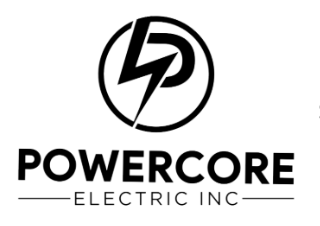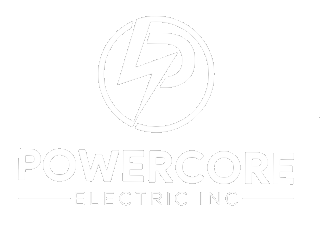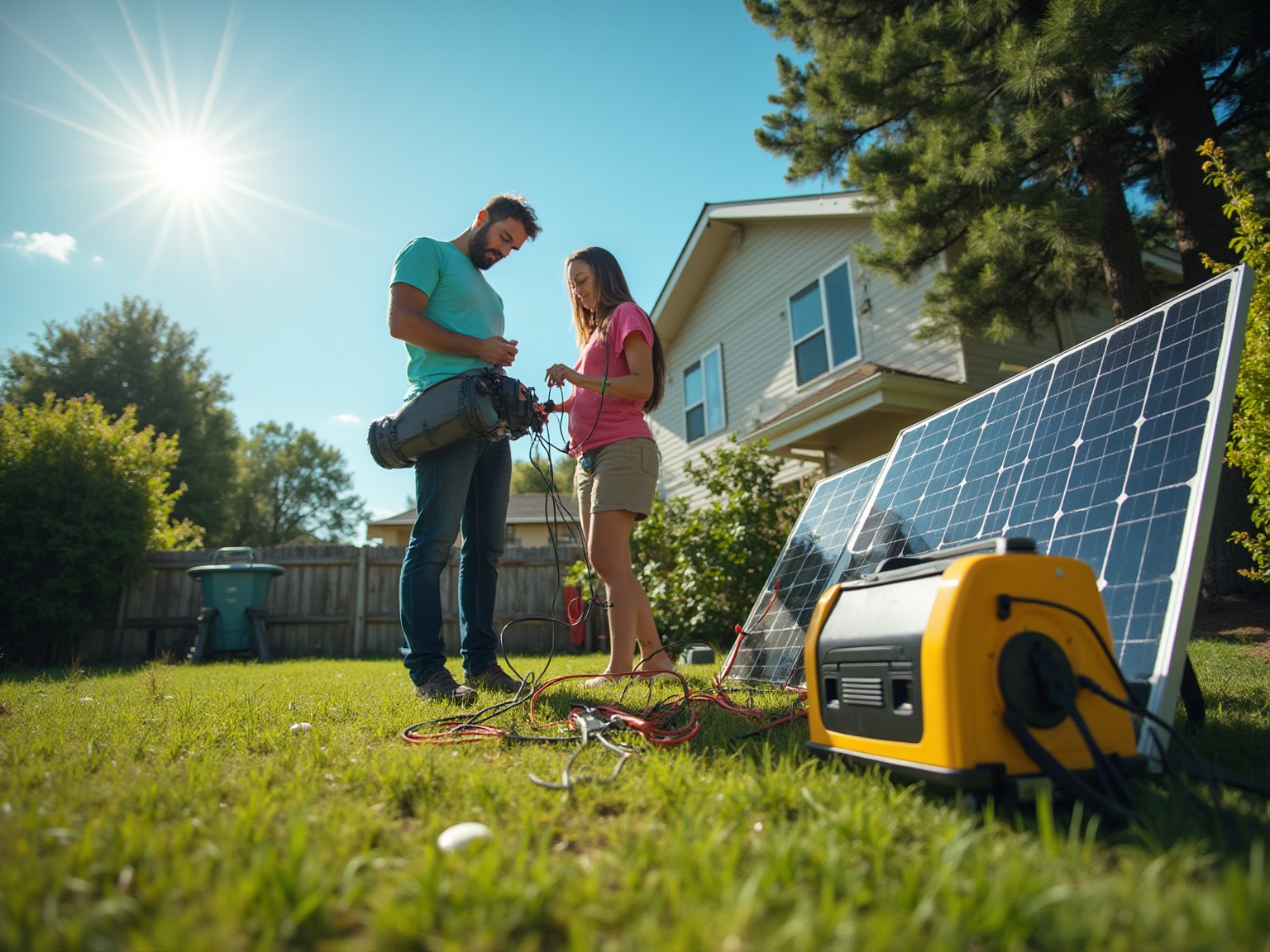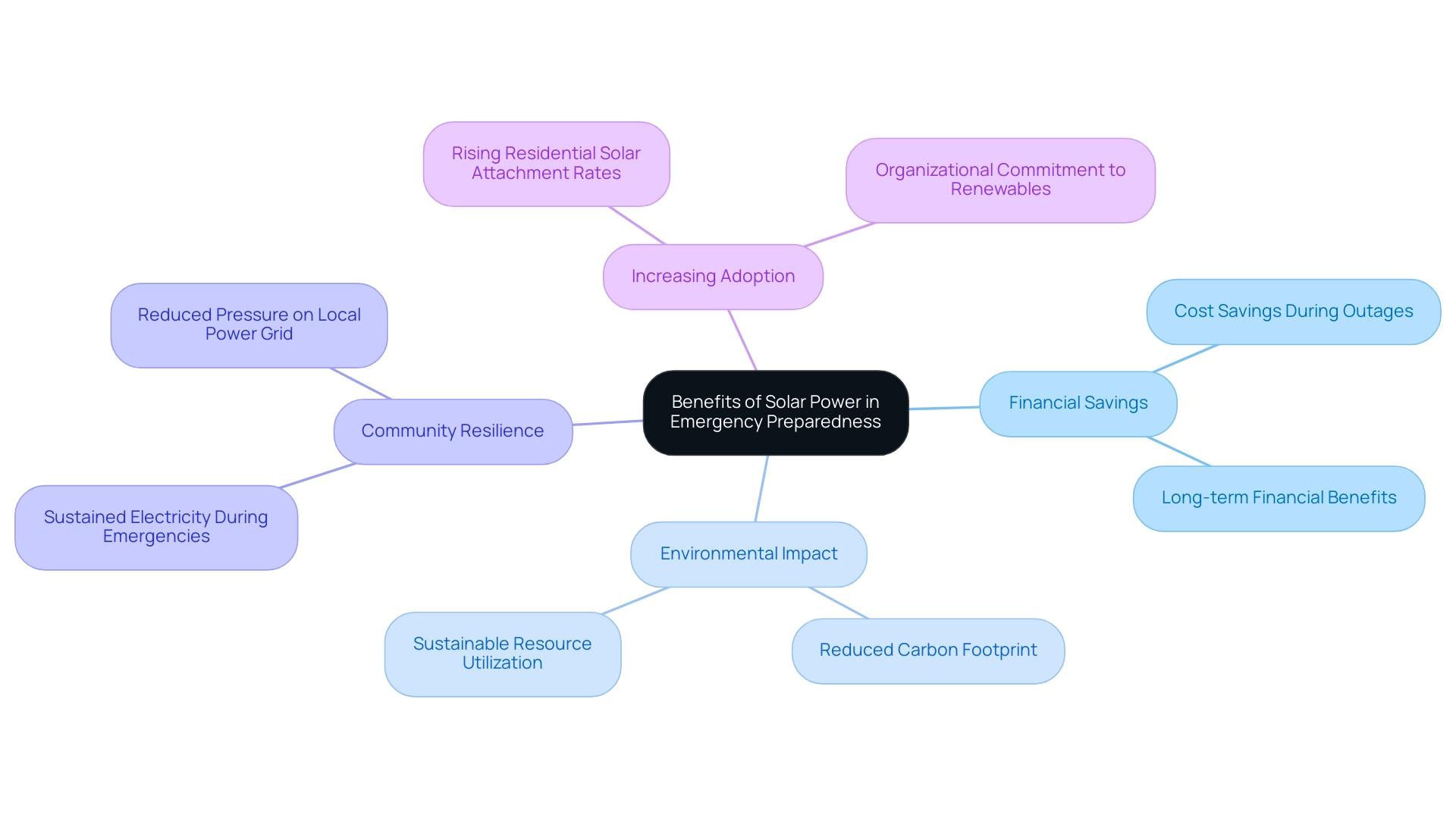Overview
We understand that reliable electricity during outages and crises is a significant concern for many homeowners, especially as extreme weather events and rising energy costs make alternative energy sources more essential than ever. Emergency solar power systems are not just a solution; they are a lifeline that enhances individual resilience and autonomy. These systems also play a vital role in supporting community recovery during disasters, demonstrating their growing importance in our modern energy preparedness strategies.
Together, we can explore how these sustainable solutions can empower you to take control of your energy needs and foster a sense of security in uncertain times. Let’s work towards a future where energy independence is not just a dream, but a reality for you and your community.
Introduction
As we navigate the challenges of rising electricity costs and the unpredictability of extreme weather, many of us are feeling the weight of these concerns. The importance of emergency solar power has never been more pronounced. These innovative systems are designed to provide reliable electricity during outages, ensuring that essential services remain operational when traditional power sources fail.
With more homeowners, especially in places like California, turning to solar solutions, the shift towards energy independence is gaining momentum. This article explores the critical components of emergency solar power systems, their applications in crisis situations, and the myriad benefits they offer in enhancing community resilience.
By delving into the challenges and future trends in this field, we can see that emergency solar power is not merely a luxury but a fundamental necessity for modern households striving for sustainability and security in an uncertain energy landscape. Together, we can embrace these solutions and work towards a more resilient future.
Defining Emergency Solar Power: An Overview
Emergency solar power is designed with your needs in mind, providing a reliable source of electricity during outages or crises. These systems typically include photovoltaic panels, inverters, and battery storage, enabling you to harness sunlight and store energy for later use. As we navigate through 2025, the importance of emergency renewable energy has become increasingly evident, especially in light of rising electricity costs and the growing frequency of severe weather events that threaten grid stability.
We understand that many homeowners in California are seeking dependable solutions. Recent statistics indicate that approximately 30% are now utilizing renewable technologies for backup electricity, marking a significant shift towards sustainable practices. This transition is driven by the desire for reliability during outages and a commitment to reducing dependence on traditional power grids.
Experts emphasize the vital role of emergency renewable sources in enhancing resilience. As industry leaders like Ben Zientara point out, these solutions not only provide crucial solar power assistance but also foster autonomy, allowing you to maintain essential services when it matters most. Zientara notes that the evolving policy landscape could greatly affect companies in the renewable energy sector, underscoring the importance of making these installations more accessible to everyone.
The relevance of such networks is further underscored by the challenges faced by electrical grids, including inflation and supply chain issues, which have historically influenced energy pricing and availability. A recent case study titled “Challenges and Resilience in Pricing for Renewable Energy” highlights the fluctuations in pricing and their implications for homeowners considering emergency solar power options. Despite notable price decreases over the last two decades, the renewable energy sector continues to navigate challenges that keep prices elevated, revealing a complex yet resilient market.
Practical applications of emergency energy systems showcase their effectiveness in various scenarios. For instance, during recent natural disasters, homeowners equipped with battery backups were able to sustain power for critical appliances, ensuring safety and comfort. This capability is especially important as utility-scale photovoltaic prices have become increasingly competitive, ranging from $16/MWh to $35/MWh, making these installations more accessible than ever.
Furthermore, evaluating the effectiveness of heating technologies reveals that high-efficiency options can save homeowners between $400 to $600 annually on utility costs, while significantly reducing greenhouse gas emissions. This aligns with the growing adoption of photovoltaic technologies, as more homeowners recognize the financial and environmental benefits of integrating these solutions into their emergency preparedness strategies.
In conclusion, emergency solar power systems are not just a luxury; they are essential for homeowners who wish to safeguard their energy needs during outages. As the energy landscape continues to evolve, incorporating emergency solar power into your preparedness plans will be crucial in ensuring that you and your family can navigate energy disruptions with confidence. Local energy firms in Stockton, California, such as Powercore Electric, offer a range of solutions tailored for environmentally-conscious homeowners.
We invite you to explore the testimonials from satisfied customers, which further highlight the effectiveness of these solutions in real-world applications. Together, we can work towards a more sustainable and secure energy future.
Applications of Emergency Solar Power in Crisis Situations
In times of crisis, particularly during natural disasters like hurricanes, wildfires, and earthquakes, emergency solar power setups become a lifeline. We understand how unsettling it can be when conventional energy sources fail, leaving vital services at risk. Emergency solar power systems are essential for supplying energy to shelters, medical facilities, and communication networks, ensuring that these critical services remain operational. For instance, photovoltaic generators have been effectively utilized in emergency shelters, providing electricity for lighting, refrigeration of medical supplies, and charging devices. This adaptability showcases the importance of solar power in disaster response efforts.
As we look ahead to 2025, the role of emergency solar power in management becomes increasingly significant. Recent trends indicate that 28% of installations now incorporate storage systems, a vital advancement that enhances power reliability. This shift not only ensures a steady energy supply but also optimizes the use of sunlight during prolonged outages. Imagine having a dependable source of energy when you need it most—this is what emergency solar power can offer.
The growing variety of solar battery options, including those from Powercore Electric and Tesla, provides homeowners with effective solutions for storing electricity. This means you can have backup resources during outages and harsh weather conditions, empowering you to face uncertainties with confidence.
Recent case studies from disasters, such as the California wildfires, highlight the effectiveness of emergency solar power generators in shelters. These systems provided crucial electricity, allowing shelters to operate independently of the grid. This capability is vital for maintaining operations during extended outages, ensuring that vulnerable populations receive the support they need.
Moreover, financial incentives for residential photovoltaic systems and power storage have positively influenced the adoption of these technologies, enhancing their effectiveness in delivering emergency solar power.
Experts in the field, including Thomas Berning, emphasize the importance of understanding the risks associated with different types of PV installations—whether ground-mounted, roof-mounted, or floating. This insight is crucial for implementing emergency energy systems effectively.
As technology continues to advance, including innovations in perovskite tandem cells that could achieve over 40% efficiency, the potential for emergency solar power to provide reliable electricity in emergencies grows. Statistics from 2025 further underline the increasing reliance on emergency solar power from sunlight applications in disaster situations, reinforcing its role as a sustainable and effective solution for preparedness.
By harnessing the power of sunlight, communities—like Long Beach renters—can better equip themselves to face the challenges posed by natural disasters. This ensures that essential services remain functional and accessible. Together, we can adopt a thorough approach to sunlight-based solutions, including evaluating leading batteries for storage from Powercore Electric, which is vital for eco-conscious homeowners looking to enhance their resilience against outages.
Benefits of Solar Power in Emergency Preparedness
The benefits of emergency solar power in renewable energy readiness are extensive and impactful, especially for those concerned about rising energy bills. We understand that relying on the conventional grid can be stressful, particularly during outages. Sunlight-based technologies offer a reliable source of electricity, ensuring that homeowners have access to emergency solar power even in times of crisis.
Moreover, photovoltaic systems are an environmentally friendly solution that aligns with sustainability objectives by utilizing renewable resources. This not only helps the planet but also provides peace of mind.
Financially, these systems can lead to significant cost savings over time. By decreasing reliance on fossil fuels, homeowners can lower their costs, which becomes especially advantageous during outages when utility rates may surge. In fact, the residential renewable energy market is witnessing a remarkable surge, with attachment rates projected to increase from 14% in 2023 to an impressive 25% in 2024. This trend highlights a rising dedication among homeowners to embrace renewable solutions, enhancing both independence and reliability.
Furthermore, the existence of such systems contributes to community resilience. By allowing neighborhoods to sustain electricity during emergencies, emergency solar power helps communities recover more quickly from disasters. Staying on a renewable island during emergencies reduces pressure on the local power grid and assists in preventing utility rate increases. This further emphasizes the significance of emergency solar power as a renewable resource in crisis situations.
It’s important to recognize that less than 500 natural disasters occurred from 1980 to 2009, underscoring the necessity of being prepared to alleviate the effects of such occurrences.
Various case studies demonstrate the efficiency of heating technologies, showcasing how households have realized substantial savings and lowered their carbon footprints. For example, a Southern California residence reported over a 70% reduction in utility costs after installing a water heating system powered by the sun. Such examples highlight the diverse applications and substantial savings associated with heating technologies that harness sunlight, making them an appealing option for various residential scenarios.
As organizations increasingly recognize the role of renewables in carbon management strategies—evidenced by a Deloitte survey indicating that 72% of respondents have plans to reduce carbon emissions—sunlight power stands out as a key player in fostering sustainable practices. Carolyn Amon, a research leader at the Deloitte Research Center for Energy and Industrials, emphasizes that decarbonization strategies are essential for a sustainable future. Real-life examples demonstrate how emergency solar power not only lowers costs during outages but also strengthens the overall resilience of communities in the face of crises.
By investing in renewable solutions, together we can ensure a brighter power future while contributing to a more sustainable and resilient society. Let’s work towards a future where we are all prepared and empowered.
Essential Equipment for Emergency Solar Power Systems
We understand that rising energy bills can be a significant concern for homeowners, especially in areas like Stockton, California, where overcast days can impact power generation. That’s why it’s important to consider essential equipment for emergency solar power setups, including:
- Solar panels
- Inverters
- Battery storage
- Charge controllers
Solar panels are pivotal in this process, converting sunlight into electricity, with the most efficient models achieving up to 22.8% efficiency. Choosing high-efficiency panels is crucial for backup operations, ensuring that you have reliable power when you need it most.
As you explore options, understanding local solar companies and their offerings can empower you to make informed decisions. Inverters play a vital role by transforming electricity from direct current (DC) to alternating current (AC), making it suitable for household use. Battery storage solutions are equally essential, retaining surplus electricity produced during sunny times, which guarantees availability during disruptions. In fact, in 2024, a significant 80% of homeowners chose battery storage primarily for backup assistance, highlighting its crucial role in resource resilience and effective management.
The capacity and performance ratings of batteries are vital, as they directly affect the efficiency of your home-based solutions. Charge controllers manage the flow of electricity to and from the batteries, ensuring they are charged efficiently and safely. Together, these components create a reliable emergency solar power solution capable of fulfilling your power requirements during crises while contributing to a sustainable future.
With Powercore Electric’s internal team of specialists ensuring top-notch installations and upkeep, you can trust in the dependability and efficiency of your emergency solar power solutions. For those contemplating alternatives, Powercore Electric offers a selection of high-efficiency photovoltaic panels and battery systems designed for overcast conditions, making them a leading option for achieving power autonomy.
As experienced content creator Inemesit Ukpanah emphasizes, incorporating advanced technology in energy solutions is crucial for improving energy independence and sustainability. Together, we can work towards a brighter, more sustainable future.
Challenges in Implementing Emergency Solar Power Solutions
Implementing emergency solar power solutions can feel overwhelming, especially when considering the various challenges that may deter homeowners from making the switch. One of the most pressing concerns is the initial investment required for purchasing and installing renewable energy equipment, which can be quite substantial. In 2025, the average cost of photovoltaic installations continues to pose a significant barrier, even amidst a general decline in prices over the past two decades.
Homeowners often find themselves weighing these upfront costs against the potential long-term savings on energy bills. It’s encouraging to note that 78% of installers anticipate selling more renewable energy systems in 2025, reflecting a growing optimism in the market despite these hurdles.
We understand that regulatory hurdles also play a critical role in the adoption of photovoltaic solutions. Permitting and zoning laws in California can complicate the installation process, leading to delays and additional expenses. While these regulations aim to ensure safety and compliance, they can unintentionally impede the transition to renewable energy.
Technical limitations further complicate the implementation of emergency solar power solutions. Adequate sunlight exposure is essential for optimal performance, and factors such as the orientation of your home and local climate can significantly impact efficiency. For instance, larger houses generally consume more electricity, necessitating larger renewable energy setups, which can increase costs and complexity.
The case study titled ‘Cost by Home Size’ illustrates how home size influences system costs, providing a more tailored perspective on the challenges you may face as a homeowner.
Despite these challenges, many homeowners are discovering effective methods to overcome the obstacles associated with renewable energy installation. Case studies reveal that individuals who prioritize essential installations often achieve better results than those attempting to add extra services like storage solutions and EV chargers. This trend aligns with findings from the case study “Homeowners’ Motivations for Solar Adoption,” which emphasizes focusing on core energy solutions that deliver immediate benefits.
Expert opinions highlight that while the initial expenses can be daunting, the long-term advantages of energy independence and reduced utility bills make this renewable energy source an appealing choice. Keith Lambert, president of Oxidizers, Inc., points out that “wiring to an existing circuit breaker box can be expensive depending on where your best bang for the buck is regarding sunlight and where your breaker box is in the house.” As the sector evolves, innovative funding alternatives and community initiatives are emerging to assist homeowners in addressing these challenges, making renewable energy more accessible than ever.
Additionally, despite a dramatic decline in photovoltaic prices over the past 20 years, the last three years have experienced volatility due to inflation and supply chain challenges, though conditions are steadily improving.
In summary, while implementing emergency solar power solutions presents several obstacles, with careful planning and investment, homeowners can effectively harness sunlight to ensure reliability during outages. This guide serves as a comprehensive resource for eco-conscious homeowners in Long Beach seeking to explore renewable energy options, assess service providers, and understand the benefits of residential panel sizing under the 200% rule.
Future Trends in Emergency Solar Power Technology
In an age where energy bills can weigh heavily on our minds, upcoming developments in emergency solar power technology are here to offer hope and transformation for homeowners preparing for outages and resource crises. Significant advancements, such as improved photovoltaic panel efficiency, the emergence of portable energy generators, and the integration of intelligent technology into renewable energy solutions, are paving the way for a brighter future. Innovations like bifacial panels, which capture sunlight from both sides, promise to enhance collection and performance when we need it most.
We understand that resilience is a priority for many. That’s why advancements in battery storage solutions are so vital; around 80% of homeowners installing battery units do so primarily for backup. This highlights a growing focus on ensuring our homes can withstand uncertainties. When assessing the top battery choices for efficient storage, capacity and performance ratings emerge as crucial factors for effective resource management and sustainability. The rise of intelligent technology empowers us to monitor and manage our power consumption in real-time, optimizing photovoltaic systems for maximum efficiency during critical moments.
As the industry navigates the uncertainties of 2025, including potential tariffs and funding pauses, we can look forward to a projected investment in photovoltaic technology reaching £162.1 billion by 2033. This indicates a robust future for renewable sources as an essential element of emergency solar power. Despite the challenges that 2024 may bring, installers remain optimistic about advancements in 2025, as noted by policy analyst Ben Zientara. Moreover, well-known incentives for renewable installations, such as statewide tax credits and storage rebates, significantly influence homeowners’ decisions regarding photovoltaic systems.
These trends not only reflect the evolving landscape of photovoltaic technology but also underscore the rising importance of sustainable solutions in protecting our homes against service interruptions. Together, we can embrace these innovations. Powercore Electric is dedicated to delivering solutions that enhance our autonomy and resilience. In comparison to gas generators, solar-powered systems offer a cleaner and more sustainable option for emergency solar power, aligning perfectly with our collective demand for eco-friendly power solutions.
Recent discussions surrounding solar energy solutions further emphasize the importance of understanding how solar panels work, the benefits of Tesla home chargers, and the impact of government programs on solar adoption. Let’s work together towards a more sustainable future, ensuring our homes are equipped to face any challenge.
Conclusion
In today’s unpredictable energy landscape, we understand the growing necessity for emergency solar power systems. These systems, which include essential components like solar panels, inverters, and battery storage, are designed to ensure a reliable electricity supply during outages. Many homeowners are beginning to recognize the financial and environmental benefits of these systems, leading to a rising trend in solar adoption—especially in areas prone to natural disasters.
Emergency solar power systems not only bolster energy independence but also enhance community resilience. Their applications during crises—such as providing power to emergency shelters and medical facilities—underscore their critical role in disaster response. As solar technology continues to evolve, advancements in efficiency and storage capabilities promise to further solidify solar power’s position as a cornerstone of emergency preparedness.
While it’s common to feel apprehensive about initial investments and regulatory hurdles, the long-term benefits of adopting solar solutions far outweigh these challenges. Insights from industry experts and real-world case studies demonstrate that with proper planning, homeowners can effectively harness solar energy to secure their energy needs during emergencies.
In conclusion, the shift towards emergency solar power is not merely an option but an imperative for modern households. Embracing these innovative solutions paves the way for a more sustainable and resilient future, equipping communities to better withstand the challenges posed by rising electricity costs and extreme weather events. As the solar industry continues to advance, let’s work together to consider the potential of emergency solar systems in safeguarding our homes and enhancing our energy security. Together, we can create a brighter, more sustainable future.



